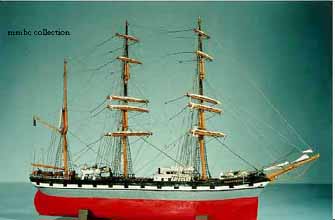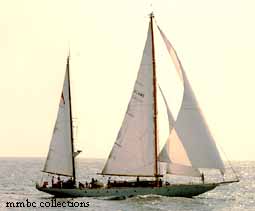
'PENRHYN CASTLE'

To conserve manpower and for better performance when sailing to windward, the use of fore-and-aft sails on the mizzen mast became popular in the latter part of the 19th century. No square sails were used on that mast in this rig. This is a sailor built mo del from the turn of the century.mmbc collection

Bigger ships of iron and steel construction required greater driving power. The addition of an extra mast, the jigger, was resorted to, and it was fore-and-aft rigged. This model is a companion to the three-masted barque.mmbc collection

Two-masted sailing vessel similar to the 'Ketch' except for a smaller mizzen mast. Originally used for fishing and coastal trading, this rig is still popular with modern yachtsman.Launched in 1921 in Massachusetts, the Oriole was purchased by the Navy League in 1941. It was used to train seacadets in Halifax until 1954 when it was transferred to Esquimalt B.C.. It continues to combine seacadet training with participation in even ts such as 'Swiftsure' and the 'Race to Maui'.
mmbc collection

An example of a clipper ship of the mid-19th century. This ship has square sails on all masts. By this period the start 'head-sails' were fore-and-aft rigged. The fore-and-aft sails between the masts were known as 'staysails'. This is a sailor-made model with sails of wood built about 1850.mmbc collection

![[English]](../simages/english.gif)
|

![[French]](../simages/french.gif)
|

![[Credits]](../simages/credit.gif)
|

![[Feedback]](../simages/feedback.gif)
|